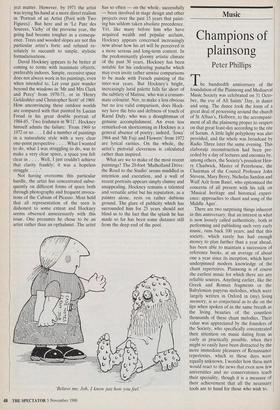Music
Champions of plainsong
Peter Phillips
The hundredth anniversary of the foundation of the Plainsong and Mediaeval Music Society was celebrated on 31 Octo- ber, the eve of All Saints' Day, in dance and song. The dance took the form of a great deal of processing around the church of St Alban's, Holborn, to the accompani- ment of all the plainsong proper to vespers on that great feast-day according to the rite of Sarum. A little light polyphony was also provided, and the whole was broadcast by Radio Three later the same evening. This elaborate reconstruction had been pre- ceded by a day of lectures and encomia by, among others, the Society's president Hen- ry Chadwick, Master of Peterhouse, the Chairman of the Council Professor John Stevens, Mary Berry, Nicholas Sandon and Wulf Arlt from Basel, who epitomised the concerns of all present with his talk on 'Musical heritage and historical experi- ence: approaches to chant and song of the Middle Ages'.
There are two surprising things inherent in this anniversary: that an interest in what is now loosely called authenticity, both in performing and publishing such very early music, runs back 100 years; and that this society, which rarely has had enough money to plan further than a year ahead, has been able to maintain a succession of reference books, at an average of about one a year since its inception, which have underpinned modern knowledge of the chant repertoires. Plainsong is of course the earliest music for which there are any reliable sources. Anything earlier, like the Greek and Roman fragments or the Babylonian papyrus melodies, which were largely written in Oxford in (my) living memory, is so conjectural as to die on the lips when spoken of in the same breath as the living beauties of the countless thousands of these chant melodies. Their value was appreciated by the founders of the Society, who specifically concentrated their attention on music dating from as early as practically possible, when they might so easily have been distracted by the more immediate pleasures of Renaissance repertories, which in those days were equally unknown. I wonder how these men would react to the news that even now few universities and no conservatoires teach their speciality, though it is a measure of their achievement that all the necessary tools are to hand for those who wish to. The original intention of the Society had been to go at chant from both the theore- tical and the practical points of view. The plan to found a choir came to nothing, and has repeatedly failed in more recent years, while the publications have regularly appeared (the latest one is of French 13th-century polyphony in the British Lib- rary). It is just possible that this choir might have ameliorised the intense bicker- ing which surrounds the performance of chant these days, which, I may say, has reached the point where one hardly dares to open one's mouth to vocalise a carefree neume or two without being engaged in heated discussion about its various musical properties.'
On second thought, such a choir could never have established the kind of authority which the Society's editions have done, fashions of performance chang- ing so much faster than those of scho- larship, and it is probably as well for its reputation that the Society has not been involved, at first hand, with the grappling. The long survival of the PMMS has been due in considerable part to the work of Dom AnseIm Hughes, who died in 1974. He first joined in 1910 and went on, as an Anglican Benedictine monk at first Per- shore and then Nashdom Abbey in Buck- inghamshire, to pioneer some of the Socie- ty's most useful work. He is perhaps best known for his editorship of The New Oxford History of Music; but he deserves to be better known for his Septuagesima: Reminiscences of the Plainsong and Mediaeval Music Society, published in 1959, which would provide any social historian interested in the prejudices of early 20th-century musicologists with a mine of information. Hughes recounts how Jacques Hanschin roundly declared at a congress in Cambridge in 1933 what many lesser musicologists bury deep in their souls by sitting on university subscription concerts committees: that he was not re- motely interested in how the music he was editing actually sounded in performance.
And Hughes was prepared to fight for standards he believed in: To my mind one of the charms of The Elements of Plainsong Is that it has hardly any footnotes. Writers in the year 1895 were content with saying what they had to say, and with trusting that their readers would do them the honour of supposing that they knew what they were writing about. Nowadays it seems impossi- ble to write a book — or at least to get it Past editorial councils — without supplying chapter and verse for every statement, although such statements may be obvious or even trite. From what quarter of the globe this poisonous habit infected English writing is not hard to guess.' At which he appends 11 spurious footnotes of his own devising to a simple paragraph from the book under review, There is something rather familiar (and English) about the tone of this, though that particular battle, I'm afraid, has been lost.



































































 Previous page
Previous page